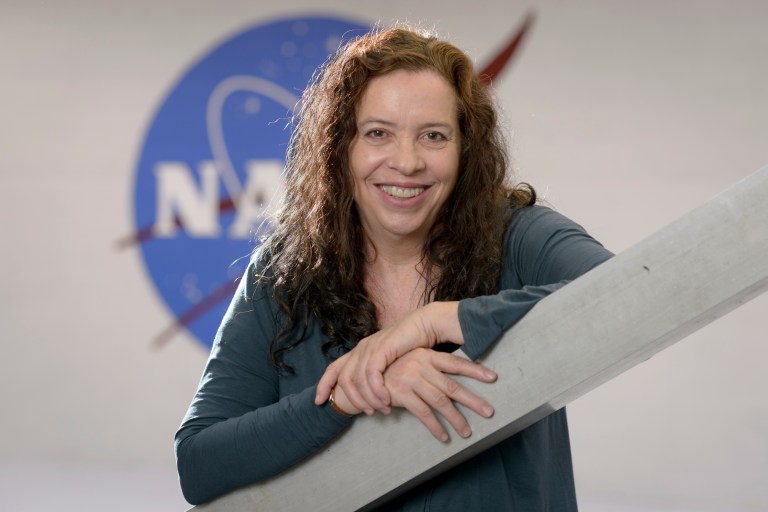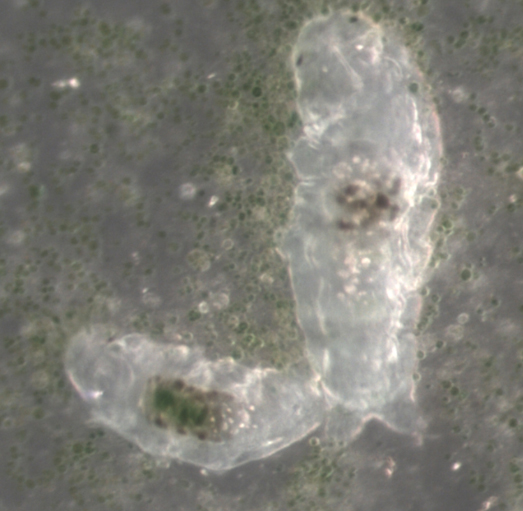
Sigrid Reinsch
Project Scientist, Director of Education and Outreach for the Ames Space Biology Program
Phone: (650) 604-3093
Email: Sigrid.Reinsch@nasa.gov
Affiliation: Space Biosciences Research Branch
Professional Background
Biography
- 1998-Present NASA Ames Research Center
- 1992-1998 European Molecular Biology Laboratory, Heidelberg, Germany
Education
- Ph.D., Cell Biology, University of California, San Francisco
- B.A., Biology, University of California, Santa Cruz
Current NASA roles
- Director: SHINE (Space Health Impacts for the NASA Experience) Training Program
- Project Scientist: NASA Biological Institutional Scientific Collection (NBISC)
- Senior Scientist (Ad hoc): GeneLab project
Research Interests
Long duration human spaceflight imposes serious health risks on astronauts. Chief among the risks is damage to cells, tissues and organs due to radiation exposure. Tardigrades are microscopic invertebrates with eight legs. There are upwards of 1000 species of tardigrades that inhabit most environmental niches on the planet. All require hydration for reproduction but some species are routinely exposed to environmental extremes. Tardigrades have been shown to be very resilient in their ability to recover from exposure to a variety of environmental stresses including ionizing radiation, desiccation, high and low temperature and pressure. Active tardigrades are generally susceptible to these stresses, however upon exposure to an environmental stress, they will shed water (anhydrobiosis) and enter a state of metabolic stasis called “cryptobiosis”. In this cryptobiotic state, the tardigrade is known as a tun and is very resistant to environmental extremes.
Certain tardigrade species have an extraordinary resistance to radiation damage and can tolerate high doses of ionizing radiation. Intriguingly while other radioresistant invertebrates only survive radiation exposure in a desiccated state (e.g. bdelloid rotifers and larvae of Polypedilum vanderplanki or sleeping chironomid), tardigrades can survive high radiation doses in the hydrated (active) state. Egg/embryos and newly hatched tardigrades are more susceptible to radiation exposure than adults. The Reinsch laboratory explores several hypotheses regarding the nature of radiation resistance in several tardigrade species.
Select Publications
- Cahill T, Cope H, Bass JJ, Overbey EG, Gilbert R, da Silveira WA, Paul AM, Mishra T, Herranz R, Reinsch SS, Costes SV, Hardiman G, Szewczyk NJ, Tahimic CGT. Mammalian and Invertebrate Models as Complementary Tools for Gaining Mechanistic Insight on Muscle Responses to Spaceflight. International Journal of Molecular Sciences. 2021; 22(17):9470.
- Overbey EG, Saravia-Butler AM, Zhang Z, Rathi KS, Fogle H, da Silveira WA, Barker RJ, Bass JJ, Beheshti A, Berrios DC, Blaber EA, Cekanaviciute E, Costa HA, Davin LB, Fisch KM, Gebre SG, Geniza M, Gilbert R, Gilroy S, Hardiman G, Herranz R, Kidane YH, Kruse CPS, Lee MD, Liefeld T, Lewis NG, McDonald JT, Meller R, Mishra T, Perera IY, Ray S, Reinsch SS, Rosenthal SB, Strong M, Szewczyk NJ, Tahimic CGT, Taylor DM, Vandenbrink JP, Villacampa A, Weging S, Wolverton C, Wyatt SE, Zea L, Costes SV, Galazka JM. NASA GeneLab RNA-seq consensus pipeline: standardized processing of short-read RNA-seq data. iScience. 2021 Mar 26;24(4):102361
- Lai Polo S-H., Saravia-Butler AM, Boyko V, Dinh MT, Chen Y-C, Fogle H, Reinsch SS, Ray S, Chakravarty K, Marcu O, Chen RB, Costes SV, Galazka JM. RNAseq analysis of rodent spaceflight experiments is confounded by sample collection techniques. iScience. 2020 Nov 25;23(12):101733.
- Willis CRG, Szewczyk NJ, Costes SV, Udransky IA, Reinsch SS, Etheridge T, Conley CA. Comparative transcriptomics identifies altered neuronal and metabolic function as common adaptations to microgravity and hypergravity in Caenorhabditis elegans. iScience. 2020 Nov 25;23(12):101734.
- Rutter L, Barker R, Bezdan D, Cope H, Costes SV, Degoricija L, Fisch KM, Gabitto MI, Gebre S, Gizcomello S, Gilroy, S, Green SJ, Mason CE, Reinsch SS, Szewczyk NJ, Taylor DM, Galazka JM, Herranz R, Muratani M. A New Era for Space Life Science: International Standards for Space Omics Processing (ISSOP). Patterns (N Y). 2020 Nov 25;1(9):100148. )
- Overbey EG, Paul AM, da Silveira WA, Tahimic CGT, Reinsch SS, Szewczyk N,Stanbouly S, Wang C, Galazka JM, Mao XW. (2019) Mice Exposed to Combined Chronic Low-Dose Irradiation and Modeled Microgravity Develop Long-Term Neurological Sequelae. Int J Mol Sci. Aug 22;20(17).
- Carney, Laura T., Reinsch*, Sigrid. S., Lane, Pamela D., Solberg, Owen D., Jansen, Lara S., Williams, Kelly P., Trent, Jonathan D. Lane, Todd W.(2014); Microbiome analysis of a microalgal mass culture growing in municipal wastewater in a prototype OMEGA photobioreactor. Algal Research 4:52-61
- Wiley, P., Harris, L., Reinsch, S., Tozzi, S., Embaye, T., Clark, K, McKuin, B., Kolber, Z., Adams, R., Kagawa, H., Richardson, T-M., Malinowski, J., Beal, C., Claxton, M.A., Geiger, E., Rask, J., Campbell, J.E., Trent, J.D. (2013) Microalgae cultivation using Offshore Membrane Enclosures for Growing Algae (OMEGA). Journal of Sustainable Bioenergy Systems 3(1):18-32
- Conway, G., Torrejon. M., Lin, S, and S.S. Reinsch. (2006) An Efficient Method for the Analysis of Neural Gene Function in Zebrafish. Brain Research 1070:150-9.
- McMenamin, S., Reinsch, S.S., and G. Conway. (2003) Direct comparison of common fixation methods for visualization of microtubules in zebrafish embryos. Biotechniques 34:468-70.
- Reinsch, S. (2001) Analyzing movement of nuclei. in Current Protocols in Cell Biology. Eds. Bonifacino, J. S., M. Dasso, J. Lippincott-Schwartz, J.B. Harford, and K.M. Yamada, John Wiley and Sons, New York.
- White, J., L. Johannes, F. Mallard, A. Girod, S. Grill, S. Reinsch, P. Keller, B. Tzschaschel, A. Echard, B. Goud, and E.H. Stelzer (1999) Rab6 Coordinates a Novel Golgi to ER Retrograde Transport Pathway in Live Cells. J. Cell Biol. 147:743-760
- Reinsch, S. and P. Gönczy (1998) Mechanisms of nuclear positioning. J. Cell Sci. 111:2283-2295.
- Reinsch, S. and E. Karsenti (1997) Movement of nuclei along microtubules in Xenopus egg extracts. Curr. Biol. 7:211-214
- Reinsch, S., S. Eaton, and E. Stelzer (1997). Confocal microscopy of polarized epithelial cells. in Cell Biology: A laboratory Handbook. Second Edition. Ed. Celis, J.E. Academic Press, London.
- Ullrich, O., S. Reinsch, S. Urbé, M. Zerial and R.G. Parton (1996). Rab11 regulates recycling through the pericentriolar recycling endosome. J. Cell Biol. 135:913-924.
- Fuller S., B. Gowen, S. Reinsch, A. Sawyer, B. Buendia, R. Wepf and E. Karsenti. (1995). The core of the mammalian centriole contains gamma-tubulin. Curr. Biol. 5, 1384-1393.
- Reinsch, S. and E. Karsenti (1994). Orientation of spindle axis and distribution of plasma membrane proteins during cell division in polarized MDCKII cells. J. Cell Biol. 126:1509-1526.
- Reinsch, S. and E. Stelzer (1994) Confocal microscopy of polarized MDCK epithelial cells. in Cell Biology: A laboratory Handbook. Ed. Celis, J.E. Academic Press, London.
- Reinsch, S.S. THESIS: (1992) Microtubule polymer assembly and transport during axonal elongation. University of California, San Francisco
- Robinson-HL; Foster-RG; Blais-BP; Reinsch-SS; Newstein-M; Shank-PR. (1992) 5′ avian leukosis virus sequences and osteopetrotic potential. Virology. 190(2): 866-871
- Reinsch, S.S., T.J. Mitchison, and M. Kirschner. (1991) Microtubule polymer assembly and transport during axonal elongation. J. Cell Biol. 115(2) 365-379
- Martin, G.R., M. Richman, S. Reinsch, J. H. Nadeau, and A. Joyner. (1990) Mapping of the two mouse engrailed-like genes: close linkage of En-1 to dominant hemimelia (Dh) on chromosome 1 and of En-2 to hemimelic extra-toes (Hx) on chromosome 5. Genomics, 6(2):302-308.
- Robinson, HL, S.S.Reinsch and P.R. Shank. (1986) Sequences near the 5′ long terminal repeat of avian leukosis viruses determine the ability to induce osteopetrosis. Journal of Virology, 59(1):45-59
*co-first authors listed alphabetically



























